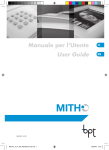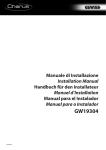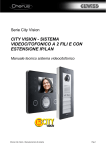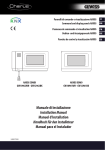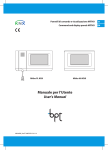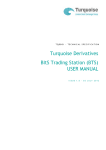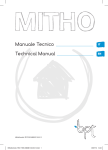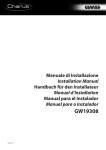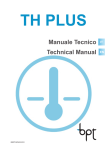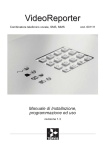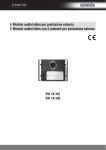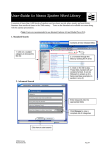Download Manuale di installazione ed utilizzo Guide for installation
Transcript
Centralino di portineria NAXOS Porter switchboard NAXOS Manuale di installazione ed utilizzo Guide for installation and use GW19202WH - GW19202BK 24808450 IT EN IT 2 INDICE AVVERTENZE . . . . . . . . . . . . . . . . . . . . . . . . . . . . . . . . . . . . . . . . . . . . . . . . . . . . . . . . . . . . . . . . . . . . . . . . . . . . . . . . Pag. 4 INSTALLAZIONE E MESSA IN SERVIZIO ASSEMBLAGGIO . . . . . . . . . . . . . . . . . . . . . . . . . . . . . . . . . . . . . . . . . . . . . . . . . . . . . . . . . . . . . . . . . . . . . . . . . . . Pag. Inserimento/rimozione della scheda MICRO SD . . . . . . . . . . . . . . . . . . . . . . . . . . . . . . . . . . . . . . . . . . . . . . . . . . . . Funzione del ponticello SW4 (Resistenza di chiusura) . . . . . . . . . . . . . . . . . . . . . . . . . . . . . . . . . . . . . . . . . . . . . . Specifiche tecniche . . . . . . . . . . . . . . . . . . . . . . . . . . . . . . . . . . . . . . . . . . . . . . . . . . . . . . . . . . . . . . . . . . . . . . . . . . . . . . . . . . Cablaggio delle prese RJ 45 . . . . . . . . . . . . . . . . . . . . . . . . . . . . . . . . . . . . . . . . . . . . . . . . . . . . . . . . . . . . . . . . . . . . . . . . . . Messa in servizio dei videoterminali . . . . . . . . . . . . . . . . . . . . . . . . . . . . . . . . . . . . . . . . . . . . . . . . . . . . . . . . . . . . . . . . 6 7 7 7 8 8 MANUALE PER L’UTENTE INFORMAZIONI GENERALI . . . . . . . . . . . . . . . . . . . . . . . . . . . . . . . . . . . . . . . . . . . . . . . . . . . . . . . . . . . . . . Pag. Caratteristiche tecniche . . . . . . . . . . . . . . . . . . . . . . . . . . . . . . . . . . . . . . . . . . . . . . . . . . . . . . . . . . . . . . . . . . . . . . . . . . . . . . Principali funzioni associate alle icone della schermata di apertura . . . . . . . . . . . . . . . . . . . . . . . . . . . . . . . Menù principale . . . . . . . . . . . . . . . . . . . . . . . . . . . . . . . . . . . . . . . . . . . . . . . . . . . . . . . . . . . . . . . . . . . . . . . . . . . . . . . . . . . . Manutenzione ed utilizzo del Terminale . . . . . . . . . . . . . . . . . . . . . . . . . . . . . . . . . . . . . . . . . . . . . . . . . . . . . . . . . . . . 10 10 11 11 11 FUNZIONI VIDEOCITOFONICHE DI PORTINERIA . . . . . . . . . . . . . . . . . . . . . . . . . . . . . . . . . . . Pag. Funzioni base . . . . . . . . . . . . . . . . . . . . . . . . . . . . . . . . . . . . . . . . . . . . . . . . . . . . . . . . . . . . . . . . . . . . . . . . . . . . . . . . . . . . . . . . Consultare l’elenco utenti . . . . . . . . . . . . . . . . . . . . . . . . . . . . . . . . . . . . . . . . . . . . . . . . . . . . . . . . . . . . . . . . . . . . . . . . . . Aggiungere utenti all’elenco dei preferiti . . . . . . . . . . . . . . . . . . . . . . . . . . . . . . . . . . . . . . . . . . . . . . . . . . . . . . . . . . . Inoltrare una chiamata . . . . . . . . . . . . . . . . . . . . . . . . . . . . . . . . . . . . . . . . . . . . . . . . . . . . . . . . . . . . . . . . . . . . . . . . . . . . . . Inviare un messaggio ad un utente . . . . . . . . . . . . . . . . . . . . . . . . . . . . . . . . . . . . . . . . . . . . . . . . . . . . . . . . . . . . . . . . . Rispondere ad una chiamata . . . . . . . . . . . . . . . . . . . . . . . . . . . . . . . . . . . . . . . . . . . . . . . . . . . . . . . . . . . . . . . . . . . . . . . . Inoltrare una chiamata ad un interno . . . . . . . . . . . . . . . . . . . . . . . . . . . . . . . . . . . . . . . . . . . . . . . . . . . . . . . . . . . . . . . Visualizzare immagini da posti esterni . . . . . . . . . . . . . . . . . . . . . . . . . . . . . . . . . . . . . . . . . . . . . . . . . . . . . . . . . . . . . . Chiamate al Portiere . . . . . . . . . . . . . . . . . . . . . . . . . . . . . . . . . . . . . . . . . . . . . . . . . . . . . . . . . . . . . . . . . . . . . . . . . . . . . . . . Messaggi di allarme o panico . . . . . . . . . . . . . . . . . . . . . . . . . . . . . . . . . . . . . . . . . . . . . . . . . . . . . . . . . . . . . . . . . . . . . . . La segreteria videocitofonica . . . . . . . . . . . . . . . . . . . . . . . . . . . . . . . . . . . . . . . . . . . . . . . . . . . . . . . . . . . . . . . . . . . . . . . . Registrare un messaggio di segreteria . . . . . . . . . . . . . . . . . . . . . . . . . . . . . . . . . . . . . . . . . . . . . . . . . . . . . . . . . . . . . . Consultare la segreteria videocitofonica . . . . . . . . . . . . . . . . . . . . . . . . . . . . . . . . . . . . . . . . . . . . . . . . . . . . . . . . . . . . 12 12 12 13 14 14 15 16 16 17 17 18 18 19 SETUP DISPOSITIVO . . . . . . . . . . . . . . . . . . . . . . . . . . . . . . . . . . . . . . . . . . . . . . . . . . . . . . . . . . . . . . . . . . . . . . Pag. Principali funzioni del menù setup . . . . . . . . . . . . . . . . . . . . . . . . . . . . . . . . . . . . . . . . . . . . . . . . . . . . . . . . . . . . . . . . . . Scegliere una melodia per le chiamate . . . . . . . . . . . . . . . . . . . . . . . . . . . . . . . . . . . . . . . . . . . . . . . . . . . . . . . . . . . . . Regolare numero e pausa degli squilli . . . . . . . . . . . . . . . . . . . . . . . . . . . . . . . . . . . . . . . . . . . . . . . . . . . . . . . . . . . . . . Regolare Data e Ora del Terminale . . . . . . . . . . . . . . . . . . . . . . . . . . . . . . . . . . . . . . . . . . . . . . . . . . . . . . . . . . . . . . . . . Setup Citofonia . . . . . . . . . . . . . . . . . . . . . . . . . . . . . . . . . . . . . . . . . . . . . . . . . . . . . . . . . . . . . . . . . . . . . . . . . . . . . . . . . . . . . Funzione Sveglia . . . . . . . . . . . . . . . . . . . . . . . . . . . . . . . . . . . . . . . . . . . . . . . . . . . . . . . . . . . . . . . . . . . . . . . . . . . . . . . . . . . . Timer . . . . . . . . . . . . . . . . . . . . . . . . . . . . . . . . . . . . . . . . . . . . . . . . . . . . . . . . . . . . . . . . . . . . . . . . . . . . . . . . . . . . . . . . . . . . . . . . Setup Tecnico . . . . . . . . . . . . . . . . . . . . . . . . . . . . . . . . . . . . . . . . . . . . . . . . . . . . . . . . . . . . . . . . . . . . . . . . . . . . . . . . . . . . . . . Scelta lingua terminale . . . . . . . . . . . . . . . . . . . . . . . . . . . . . . . . . . . . . . . . . . . . . . . . . . . . . . . . . . . . . . . . . . . . . . . . . . . . . Regolazione luminosità display . . . . . . . . . . . . . . . . . . . . . . . . . . . . . . . . . . . . . . . . . . . . . . . . . . . . . . . . . . . . . . . . . . . . Reset dispositivo . . . . . . . . . . . . . . . . . . . . . . . . . . . . . . . . . . . . . . . . . . . . . . . . . . . . . . . . . . . . . . . . . . . . . . . . . . . . . . . . . . . . Info Terminale . . . . . . . . . . . . . . . . . . . . . . . . . . . . . . . . . . . . . . . . . . . . . . . . . . . . . . . . . . . . . . . . . . . . . . . . . . . . . . . . . . . . . . 20 20 20 21 22 23 23 24 25 26 26 27 27 SCHEMI DI INSTALLAZIONE - INSTALLATION DIAGRAMS . . . . . . . . . . . . . . . . . . . . . . . Pag. 56 3 IT Installazione e messa in servizio AVVERTENZE Le informazioni pubblicate nel presente manuale contengono diritti di Gewiss S.p.a. o dei suoi fornitori e non possono essere riprodotte in qualsiasi maniera né trasmesse ad altri. Le informazioni contenute nel presente manuale sono soggette a modifiche senza preavviso. Gewiss S.p.a. non assume alcuna responsabilità per gli eventuali errori che il presente documento può contenere. Nessuna parte del presente manuale può essere riprodotta in qualsiasi forma o mezzo elettronico o meccanico, per alcun uso, senza il permesso scritto di Gewiss S.p.a.. ATTENZIONE IT • Dopo aver tolto l’imballaggio assicurarsi dell’integrità dell’apparecchio. • Gli elementi dell’imballaggio (sacchetti in plastica, polistirolo espanso, ecc.) non devono essere lasciati alla portata dei bambini in quanto potenziali fonti di pericolo. • Leggere attentamente le istruzioni, prima di iniziare l’installazione ed eseguire gli interventi come specificato dal costruttore. • Prima di collegare l’apparecchio accertarsi che i dati di targa siano rispondenti a quelli della rete di distribuzione. • A monte dell’apparecchio, sull’impianto elettrico dell’edificio, deve essere presente un interruttore di rete onnipolare con una separazione dei contatti di almeno 3 mm. • Il costruttore non può essere considerato responsabile per eventuali danni derivanti da usi impropri, erronei ed irragionevoli. • Prima di effettuare qualunque operazione di pulizia o di manutenzione, disinserire l’apparecchio dalla rete di alimentazione elettrica, aprendo l’interruttore dell’impianto. • In caso di guasto e/o cattivo funzionamento dell’apparecchio, distaccarlo dall’alimentazione e non manometterlo. • Utilizzare sempre ricambi originali. • L’installazione, la programmazione, la messa in servizio e la manutenzione del prodotto deve essere effettuata soltanto da personale tecnico qualificato ed opportunamente addestrato nel rispetto delle normative vigenti ivi comprese le osservanze sulla prevenzione infortuni. • Operare in ambienti sufficientemente illuminati e idonei per la salute e utilizzare strumenti, utensili ed attrezzature in buono stato. • Al termine dell’installazione verificare sempre il corretto funzionamento dell’apparecchiatura e dell’impianto nel suo insieme. • Non installare il dispositivo all’esterno o in luoghi dove sia sottoposto a stillicidio o a spruzzi d’acqua. • Trattare con cura il dispositivo, contiene parti elettroniche fragili e sensibili all’umidità. • Le schede elettroniche possono essere seriamente danneggiate dalle scariche elettrostatiche: qualora vi sia bisogno di maneggiarle indossare idonei indumenti e calzature anti statiche o, almeno, assicurarsi preventivamente di aver rimosso ogni carica residua toccando con la punta delle dita una superficie metallica connessa all’impianto di terra (es. lo chassis di un elettrodomestico). • Saldare le giunzioni tra i fili onde evitare falsi allarmi causati dall’ossidazione dei fili stessi. • L’impianto elettrico dovrà essere realizzato in conformità con le normative in vigore nel paese di installazione. • Il mancato rispetto di quanto sopra può compromettere la sicurezza dell’apparecchio. • L’installatore deve assicurarsi che le informazioni per l’utente, dove previste, siano presenti sugli apparecchi. • Lo smaltimento dei componenti va eseguito secondo quanto stabilito dalle normative vigenti. 4 Installazione e messa in servizio Installazione e messa in servizio 5 IT Installazione e messa in servizio ASSEMBLAGGIO Rimuovere il supporto metallico dall’apparecchio facendolo scorrere su di esso dopo aver premuto il pulsante 1 (fig. 1). 2 IT 1 1 Fissare il supporto metallico al corpo del piedistallo mediante le viti in dotazione (fig. 2). 2 Inserire i morsetti precablati negli appositi alloggiamenti (fig. 3) e riagganciare il terminale al supporto da tavolo. 3 6 Installazione e messa in servizio ASSEMBLAGGIO Inserimento/rimozione della scheda MICRO SD ATTENZIONE MICRO SD Prima di inserire o togliere la MICRO SD, togliere l’alimentazione al videoterminale rimuovendo le morsettiere M1 e M2. 4 Funzione del ponticello SW4 (Resistenza di chiusura) L’apparecchio dispone di un ponticello SW4, per l’impedenza di chiusura di fine linea dell’impianto di videocitofonia. Togliere il ponticello se la linea prosegue verso altri posti interni videocitofonici. SW4 Specifiche tecniche • • • • • Display 16:9 wide screen 4.3”, 480x272 pixel, touch screen. Temperatura di funzionamento: da 5 °C a 40 °C. Alimentazione: 14÷24 V DC locale (12÷16 V AC locale). Assorbimento: 0.75 A (1.5 A di picco) 12 V AC – 0.5 A (1.1 A di picco) 16 V AC, 0.31 A (0,81 A di picco) 18 V DC – 0.23 A (0,58 A di picco) 24 V DC. Dimensioni: 203 x 108 x 31 mm. 7 IT Installazione e messa in servizio ASSEMBLAGGIO Cablaggio delle prese RJ 45 1 2 IT 1......8 1 2 3 4 5 6 7 8 IT - Presa/Spina RJ 45 Morsetto Pin Morsetto Pin IT - Presa/Spina RJ 45 Cosa connettere ai morsetti della presa Linea B Alimentazione locale Chiamata dal pianerottolo Alimentazione locale BUS MultiMaster 1......8 1 2 3 4 5 6 7 8 ATTENZIONE Cosa connettere ai morsetti della presa Liberi Alimentazione locale Ingresso Allarme Comune Alimentazione locale Libero Libero L’alimentazione deve necessariamente essere collegata ad una sola presa RJ45. Perciò, in funzione delle necessità installative, collegare i morsetti pin3 e pin6 della presa 1 o della presa 2. È vietato collegarle contemporaneamente ad entrambe le prese. Messa in servizio dei videoterminali Per la messa in servizio dei videoterminali consultare il capitolo “Setup Tecnico”. 8 Manuale per l’Utente Manuale per l’Utente 9 IT Manuale per l’Utente INFORMAZIONI GENERALI Caratteristiche tecniche 203,5 120 2 4 IT 5 1 140 3 1 – Altoparlante (vivavoce) 2 – Cornetta 3 – Microfono 4 – Display 16:9 touch screen 4,3” 6 5 – Alloggiamento penna per touch screen 6 – Prese RJ45 Nota: Dopo 5 minuti di permanenza inattiva in una qualunque schermata il terminale ritornerà automaticamente alla schermata di apertura e la luminosità dello schermo verrà attenuata (secondo impostazioni di setup). 10 Manuale per l’Utente INFORMAZIONI GENERALI Principali funzioni associate alle icone della schermata di apertura La schermata di apertura permette di accedere rapidamente ed in maniera intuitiva a tutte le funzioni gestibili dal terminale NAXOS e di avere un immediato feed back degli eventi che interessano il sistema. Menù principale Sveglia attiva Intercettazione delle chiamate da parte del portiere NON ATTIVA Luce scale Intercettazione delle chiamate da parte del portiere ATTIVA Comando ausiliario Chiamata ad un portiere secondario L’icona appare attivando la modalità building Accesso alla lista dei preferiti Attivazione telecamera del posto esterno Accesso all’elenco utenti utenti Accesso all’elenco dei messaggi di allarme o panico IT esterno messaggi chiamate segreteria setup Accesso ai messaggi di segreteria L’icona lampeggiante indica la presenza di messaggi Apriporta Attivazione segreteria videocitofonica Accesso all’elenco delle chiamate L’icona lampeggiante indica la presenza di chiamate Setup Dispositivo Manutenzione ed utilizzo del Terminale •Utilizzare il terminale solo con la penna in dotazione; non utilizzare utensili, penne o altri strumenti appuntiti che potrebbero danneggiare il display e comprometterne il funzionamento. •Non esporre lo schermo LCD alla luce diretta del sole. •Per la pulizia utilizzare solo panni morbidi ed asciutti oppure leggermente inumiditi con acqua; non utilizzare alcun tipo di prodotto chimico. •Per bloccare il touch screen e permetterne la pulizia premere e mantenere premuta la penna in dotazione nell’area “data ora” fino all’oscuramento dello schermo e alla comparsa del lucchetto arancione; procedere allo stesso modo per sbloccare lo schermo. 11 Manuale per l’Utente FUNZIONI VIDEOCITOFONICHE DI PORTINERIA Funzioni base 4 utenti IT Consultare l’elenco utenti esterno 1 messaggi chiamate segreteria setup Premere il pulsante 1 per accedere all’elenco utenti. 1 B Per trovare l’utente desiderato, scorrere l’elenco utilizzando i pulsanti oppure premere il pulsante B per ottenere una schermata con l’elenco completo degli utenti suddivisi in raggruppamenti alfabetici (funzione molto utile in impianti con elevato numero di utenti). 2 Selezionare il gruppo all’interno del quale si trova l’utente desiderato. C Nota: Il pulsante C riporta alla schermata di figura 2. 3 12 Manuale per l’Utente FUNZIONI VIDEOCITOFONICHE DI PORTINERIA Aggiungere utenti all’elenco dei preferiti 4 utenti esterno messaggi chiamate segreteria setup Premere il pulsante 4 per accedere all’elenco degli utenti preferiti. Nota: Al primo accesso l’elenco risulterà vuoto. IT 4 Premere il pulsante completo degli utenti. per visualizzare l’elenco 5 Selezionare tutti gli utenti da aggiungere all’elenco dei preferiti. 6 Premere nuovamente il pulsante l’elenco degli utenti preferiti. per visualizzare Nota: L’elenco utenti preferiti è molto utile per impianti con elevato numero di utenti per semplificare la ricerca di quelli più richiesti. 7 13 Manuale per l’Utente FUNZIONI VIDEOCITOFONICHE DI PORTINERIA Inoltrare una chiamata Selezionare l’utente desiderato dall’elenco generale o da quello dei preferiti per avviare immediatamente la chiamata. IT 8 - - - - > - - - - Chiamata in corso < - - - - - - - > Comunicazione stabilita utenti esterno messaggi chiamate segreteria setup 9 Inviare un messaggio ad un utente É possibile inviare una notifica di chiamata ad un utente. Dopo avere individuato nell’elenco l’utente desiderato, selezionare l’icona e successivamente il nome dell’utente. 10 11 14 Nota: Non tutti i derivati interni sono abilitatia ricevere messaggi dal portiere; Il messaggio consiste nell’accensione di un led o un breve messaggio riportante data e ora dell’invio a seconda del modello di posto interno montato nell’abitazione dell’utente. Manuale per l’Utente FUNZIONI VIDEOCITOFONICHE DI PORTINERIA Rispondere ad una chiamata In caso di chiamata, la schermata principale viene automaticamente sostituita dalla schermata che mostra l’immagine del chiamante ripreso dal posto videocitofonico esterno. 2 1 12 Rispondendo alla chiamata si avranno a disposizione i seguenti comandi. 4 3 Premere il pulsante 1 per rifiutare la chiamata. Per rispondere alla chiamata sollevare il ricevitore oppure premere il pulsante 2 per attivare la modalità vivavoce. I pulsanti 3 e 4 consentono di rimpicciolire/ ingrandire l’immagine visualizzata. Agendo con la penna in dotazione sull’immagine ingrandita è possibile spostare l’inquadratura nella posizione desiderata 5 Accesso al comando ausiliario e luce scale 6 Visualizza immagini da posto esterno successivo (se presente) 7 Apriporta del posto esterno visualizzato* 8 Accesso alle regolazioni video (luminosità, contrasto, colore) 9 Chiusura audio verso il chiamante (funzione mute) J Accesso alla lista utenti per trasferimento chiamata 13 5 6 7 8 J 9 14 *La chiave di colore verde indica che la porta è aperta, se il posto esterno è predisposto per inviare tale informazione. 15 IT Manuale per l’Utente FUNZIONI VIDEOCITOFONICHE DI PORTINERIA Inoltrare una chiamata ad un interno Dopo aver risposto ad una chiamata, premere il pulsante per accedere all’elenco utenti; ricercare l’utente desiderato e inoltrare la chiamata. IT 15 utenti esterno messaggi segreteria chiamate K setup 16 Una volta stabilita la comunicazione con l’utente desiderato e verificata la sua disponibilità a ricevere la chiamata, premere il pulsante K per mettere in comunicazione il posto esterno con l’utente. Nota: Se non viene premuto il pulsante mute, la comunicazione audio tra la postazione di portineria ed il posto esterno, rimane attiva fino a quando la chiamata non viene trasferita all’utente desiderato. Visualizzare immagini da posti esterni utenti L esterno messaggi chiamate segreteria setup 17 18 16 M N O P Q R Dalla schermata principale selezionare l’icona L, immediatamente sarà possibile visualizzare le immagini riprese dalle telecamere dei posti esterni (se più di uno). M Accesso al comando ausiliario e luce scale N Visualizza immagini da posto esterno successivo (se presente) O Apriporta del posto esterno visualizzato* P Accesso alle regolazioni video (luminosità, contrasto, colore) Q Torna alla schermata precedente R Apri/Chiudi audio verso posto esterno visualizzato *La chiave di colore verde indica che la porta è aperta. (funzione disponibile se il posto esterno è predisposto per inviare tale informazione). Manuale per l’Utente FUNZIONI VIDEOCITOFONICHE DI PORTINERIA Chiamate al Portiere utenti esterno messaggi 1 segreteria chiamate Gli utenti possono chiedere di essere contattati dal Portiere inviando una chiamata. La presenza di chiamate è evidenziata dal lampeggio dell’icona 1; premere l’icona per accedere all’elenco chiamate. setup IT 19 Le chiamate sono raccolte in pulsanti che riportano il nome dell’utente, ora e data della chiamata; premendo il pulsante desiderato, l’utente verrà richiamato immediatamente. Per cancellare una chiamata dall’elenco, premere il pulsante 2 e selezionare la chiamata da eliminare. 2 20 Messaggi di allarme o panico utenti messaggi esterno chiamate 3 segreteria setup Gli utenti possono inviare, mediante appositi pulsanti o contatti, messaggi di allarme o panico al portiere. La presenza di messaggi è evidenziata dal lampeggio dell’icona 3; premere l’icona per accedere all’elenco dei messaggi 21 2 messages 1. Allarme, Bianchi - - 9:26 10-05-2010 La schermata, contiene l’elenco delle chiamate in ordine cronologico; il pulsante “C” cancella tutte le voci in elenco. 2. Panico, Dinieri - - 8:46 10-05-2010 Nota: Tutte le segnalazioni al portiere sono accompagnate da un tono di allarme. 22 17 Manuale per l’Utente FUNZIONI VIDEOCITOFONICHE DI PORTINERIA La segreteria videocitofonica utenti esterno messaggi IT segreteria chiamate 6 4 setup NAXOS consente di registrare un messaggio che può venire riprodotto dal posto esterno in caso di assenza del portiere. Il chiamante, in risposta, potrà lasciare un videomessaggio (riportante data e ora della chiamata) in una videosegreteria. 23 Registrare un messaggio di segreteria melodie sveglia data/ora timers citofonia 24 25 5 tecnico Dalla schermata principale selezionare l’icona 4 e successivamente l’icona 5. La schermata che appare, contiene i comandi necessari per registrare e riascoltare il messaggio da lasciare in segreteria. Una volta registrato il messaggio sarà possibile, mediante i pulsanti “OFF” e “ON”, decidere se esso debba essere riprodotto in caso di chiamata senza risposta. ON Riproduzione messaggio di segreteria ON OFF Riproduzione messaggio di segreteria OFF Nota: Il messaggio di segreteria può avere una durata massima di 10 secondi, al termine della riproduzione del messaggio il posto esterno emetterà un segnale acustico. Per attivare la segreteria videocitofonica (con o senza riproduzione del messaggio) premere l’icona 6 sulla schermata principale. Segreteria Attiva Segreteria NON Attiva 26 18 Manuale per l’Utente FUNZIONI VIDEOCITOFONICHE DI PORTINERIA Consultare la segreteria videocitofonica utenti esterno messaggi La presenza di messaggi videocitofonici non letti in segreteria è rivelata dall’icona 7 lampeggiante sulla schermata principale. chiamate segreteria 7 setup IT 27 Selezionare l’icona 7 per accedere all’elenco dei messaggi registrati in ordine cronologico, partendo dal più recente. I messaggi non letti sono contrassegnati dall’icona . Per visualizzare un messaggio videocitofonico premere sul pulsante corrispondente. 28 Il pulsante 8< cancella il messaggio che si sta visualizzando. 8 29 Nota: La segreteria può contenere un massimo di 10 messaggi, l’undicesimo messaggio sovrescriverà il primo in ordine cronologico. 19 Manuale per l’Utente SETUP DISPOSITIVO Principali funzioni del menù setup utenti esterno messaggi IT Dalla schermata principale, premere sull’icona “setup” 1. chiamate segreteria 1 setup 1 Il menù “setup” raccoglie tutte le impostazioni di base del terminale NAXOS. melodie sveglia data/ora timers citofonia tecnico 2 Scegliere una melodia per le chiamate ESTERNO PIANEROT. 2 SVEGLIA TONI Premendo sul pulsante “melodie” si accede alla schermata che presenta un elenco delle tipologie di chiamata 2 alle quali è possibile associare una delle suonerie disponibili. Selezionare un tipo di chiamata. 3 Dall’elenco delle suonerie disponibili selezionare quella che si desidera associare alla chiamata. Le frecce sulla parte superiore dello schermo permettono di regolare il volume ed il pulsante centrale “PLAY” consente di ascoltare una anteprima della suoneria scelta. 4 20 Manuale per l’Utente SETUP DISPOSITIVO ESTERNO SVEGLIA PIANEROT. Premendo il pulsante “TONI” 3 è possibile attivare/disattivare il suono associato alla pressione dei pulsanti e regolarne il volume con le frecce poste sulla parte superiore della finestra. TONI 3 IT 5 Regolare numero e pausa degli squilli ESTERNO SVEGLIA PIANEROT. Numero di squilli e pausa tra gli stessi possono venire modificati sulle suonerie che presentano l’icona . TONI 4 Premere il pulsante 4 e selezionare la suoneria da regolare. 6 Selezionare il pulsante 5 per modificare (mediante le frecce laterali) il numero di squilli massimi per il tipo di chiamata selezionato. Numero squilli 5 Pausa tra squilli 6 Selezionare il pulsante 6 per modificare (mediante le frecce laterali) la pausa che deve intercorrere tra gli squilli per il tipo di chiamata selezionato. 7 21 Manuale per l’Utente SETUP DISPOSITIVO Regolare Data e Ora del Terminale 7 Premere sul pulsante “data/ora”. Per impostare l’ora esatta selezionare il pulsante 7 e premere il pulsante “SET”. 8 GG MM AA IT Sulla tastiera che appare, digitare l’ora esatta e premere “OK”. 8 Per impostare giorno, mese, anno corrente selezionare il pulsante 8 e premere il pulsante “SET”. Sulla tastiera che appare, digitare giorno, mese, anno correnti e premere “OK”. 9 Il pulsante 9 (premuto ripetutamente) consente di scegliere il formato di visualizzazione della data. Il pulsante J consente di scegliere il formato di visualizzazione dell’ora. GG MM AA 9 J 10 Il pulsante K (attivo) abilita l’ora legale. GG MM AA 11 22 K Manuale per l’Utente SETUP DISPOSITIVO Setup Citofonia Premere sul pulsante “citofonia”. La schermata che appare, contenente i comandi necessari per registrare e riascoltare il messaggio da lasciare in segreteria. IT Vedi capitolo “La segreteria Videocitofonica” 12 Funzione Sveglia L M Selezionare l’icona “sveglia”. Per impostare l’ora di sveglia selezionare il pulsante L e premere il pulsante “SET”. Sulla tastiera che appare, digitare l’ora di sveglia desiderata e premere “OK”. Nota: Programmando solo l’ora di sveglia la suoneria verrà riprodotta tutti i giorni. 13 Per impostare il giorno di sveglia selezionare il pulsante M e premere il pulsante “SET”. Sulla tastiera che appare, digitare il giorno, mese e anno di sveglia desiderata e premere “OK”. Il giorno e l’ora impostati vengono visualizzati nel riquadro N. 14 ON Sveglia attivata OFF Sveglia disattivata Con una sveglia attiva, accanto all’ora corrente verrà visualizzata l’icona (vedi figura 1). N 15 Nota: Per fare in modo che una sveglia impostata per un determinato giorno diventi ripetitiva è sufficiente cancellare il giorno programmato mediante il pulsante “C” (fig. 14). 23 Manuale per l’Utente SETUP DISPOSITIVO Timer lun mar mer gio ven sab dom IT Il menù “timer” consente di programmare 4 fasce orarie giornaliere, nel corso delle quali il centralino di portineria viene attivato automaticamente per intercettare le chiamate. Premere su uno dei 4 pulsanti che rappresentano le fasce orarie per iniziare la programmazione. 16 Con il pulsante (inizio) attivo digitare l’ora di inizio della prima fascia oraria; premere il pulsante “OK” per confermare i dati inseriti; selezionare il pulsante (fine) e digitare l’ora di fine della prima fascia oraria e premere il pulsante “OK” per confermare i dati inseriti. Premere per tornare alla finestra di riepilogo. 17 Selezionare la fascia oraria successiva da programmare e procedere in modo analogo. lun mar mer gio ven sab dom 18 Una volta terminata la programmazione delle fasce orarie, selezionare sulla barra superiore i giorni in cui devono essere applicate. lun mar mer gio ven sab dom 19 24 Il “LED” giallo indica che la fascia oraria di attività è in corso di applicazione. Manuale per l’Utente SETUP DISPOSITIVO Intercettazione chiamate NON attiva utenti esterno messaggi chiamate segreteria setup Intercettazione chiamate Attiva Nota: L’intercettazione delle chiamate può essere forzata mediante l’apposito pulsante sulla finestra principale. 20 Setup Tecnico Selezionare l’icona “tecnico”. O Le funzioni di setup tecnico sono riservate a personale qualificato per questo motivo l’accesso può essere protetto da password. P 21 Per assegnare una password di accesso al menù “tecnico”, selezionare il pulsante O. Digitare una password e premere il pulsante . La password memorizzata verrà richiesta ogni volta che si tenterà di accedere al menù “tecnico”. Se non viene digitato alcun carattere alfanumerico in fase di registrazione della password, essa viene disabilitata e non verrà richiesto l’inserimento di alcuna password al successivo ingresso nel menù “tecnico”. Nuova Password Premere il pulsante P per accedere alle funzioni di programmazione del menù tecnico. 22 Attivando la funzione “building”, verrà attivato sul menù principale il pulsante che permette la chiamata ad un portiere secondario. building MM Attivando la funzione “MM” verranno sincronizzate, le funzioni orologio, data, segreteria e privacy tra i terminali connessi mediante bus MM. Q invio sn 23 PAL - > NTSC R Il pulsante Q permette di salvare la configurazione del terminale nella scheda di memoria removibile. 25 IT Manuale per l’Utente SETUP DISPOSITIVO L’operazione è di notevole importanza nei casi in cui si debba aggiornare il firmware del terminale o nel caso in cui si voglia trasferire una configurazione da un terminale ad un altro con stesso codice chiamata. Il pulsante “invio sn” è necessario all’identificazione del dispositivo qualora si stia programmando l’impianto da PC. IT Il pulsante R permette di selezionare lo standard del segnale video dell’ impianto tra PAL e NTSC. Premere il pulsante “PAL -> NTSC” per passare da PAL a NTSC, premere il pulsante “NTSC -> PAL” per passare da NTSC a PAL. Scelta lingua terminale melodie data/ora citofonia 1 2 3 sveglia Premere sul pulsante 1 per scegliere la lingua desiderata per l’interfaccia utente. timers tecnico 24 Regolazione luminosità display Premere sul pulsante 2 : 4 5 Selezionare il pulsante 4 ed agire sul cursore che appare sulla parte alta dello schermo per regolare la luminosità del display. 25 Selezionare il pulsante 5 per regolare la luminosità del display quando il terminale si trova in modalità stand-by (luminosità attenuata). 26 26 Manuale per l’Utente SETUP DISPOSITIVO Info Terminale Il pulsante “INFO” 3 (fig. 24) permette di visualizzare una serie di informazioni tecniche sul terminale che possono tornare utili al Vostro installatore per aggiornamenti del software o interventi tecnici. IT 27 RESET Reset dispositivo Ogni volta che anomalie di funzionamento, interventi e altre ragioni tecniche richiedono il reset dell’apparecchio, premere leggermente il pulsante collocato all’interno dell’apertura al di sotto della scocca del dispositivo (vedi figura), utilizzando il pennino in dotazione; rilasciare il pulsante appena lo schermo si oscura e attendere che riappaia il menù principale prima di riprendere l’uso normale dell’apparecchio. Nota: Questa operazione NON comporta la cancellazione di eventuali programmi che saranno ripristinati, assieme agli altri dati, al riavvio dell’apparecchio. 27 Manuale per l’Utente IT 28 CONTENTS WARNINGS . . . . . . . . . . . . . . . . . . . . . . . . . . . . . . . . . . . . . . . . . . . . . . . . . . . . . . . . . . . . . . . . . . . . . . . . . . . . . . . . . . Pag. 30 INSTALLATION AND COMMISSIONING ASSEMBLY . . . . . . . . . . . . . . . . . . . . . . . . . . . . . . . . . . . . . . . . . . . . . . . . . . . . . . . . . . . . . . . . . . . . . . . . . . . . . . . . . . . Pag. 32 Insertion/removal of the MICRO SD card . . . . . . . . . . . . . . . . . . . . . . . . . . . . . . . . . . . . . . . . . . . . . . . . . . . . . . . . . . . . Function of the jumper SW4 (Closure resistance)) . . . . . . . . . . . . . . . . . . . . . . . . . . . . . . . . . . . . . . . . . . . . . . . . . . Technical specifications . . . . . . . . . . . . . . . . . . . . . . . . . . . . . . . . . . . . . . . . . . . . . . . . . . . . . . . . . . . . . . . . . . . . . . . . . . . . Wiring of the RJ 45 sockets . . . . . . . . . . . . . . . . . . . . . . . . . . . . . . . . . . . . . . . . . . . . . . . . . . . . . . . . . . . . . . . . . . . . . . . . . . Commissioning of video terminals . . . . . . . . . . . . . . . . . . . . . . . . . . . . . . . . . . . . . . . . . . . . . . . . . . . . . . . . . . . . . . . . . . 33 33 33 34 34 USER’S MANUAL GENERAL INFORMATION . . . . . . . . . . . . . . . . . . . . . . . . . . . . . . . . . . . . . . . . . . . . . . . . . . . . . . . . . . . . . . . . Pag. 36 Technical Features . . . . . . . . . . . . . . . . . . . . . . . . . . . . . . . . . . . . . . . . . . . . . . . . . . . . . . . . . . . . . . . . . . . . . . . . . . . . . . . . . . . Main functions associated with the icons on the opening screen . . . . . . . . . . . . . . . . . . . . . . . . . . . . . . . . . . Main menu . . . . . . . . . . . . . . . . . . . . . . . . . . . . . . . . . . . . . . . . . . . . . . . . . . . . . . . . . . . . . . . . . . . . . . . . . . . . . . . . . . . . . . . . . . Maintenance and Use of the Terminal . . . . . . . . . . . . . . . . . . . . . . . . . . . . . . . . . . . . . . . . . . . . . . . . . . . . . . . . . . . . . . 36 37 37 37 PORTER VIDEO ENTRY CONTROL FUNCTIONS . . . . . . . . . . . . . . . . . . . . . . . . . . . . . . . . . . . . . Pag. Standard functions . . . . . . . . . . . . . . . . . . . . . . . . . . . . . . . . . . . . . . . . . . . . . . . . . . . . . . . . . . . . . . . . . . . . . . . . . . . . . . . . . . Consult the user list . . . . . . . . . . . . . . . . . . . . . . . . . . . . . . . . . . . . . . . . . . . . . . . . . . . . . . . . . . . . . . . . . . . . . . . . . . . . . . . . Add the user to the preferred list . . . . . . . . . . . . . . . . . . . . . . . . . . . . . . . . . . . . . . . . . . . . . . . . . . . . . . . . . . . . . . . . . . . Forwarding a call . . . . . . . . . . . . . . . . . . . . . . . . . . . . . . . . . . . . . . . . . . . . . . . . . . . . . . . . . . . . . . . . . . . . . . . . . . . . . . . . . . . . Sending a message to a user . . . . . . . . . . . . . . . . . . . . . . . . . . . . . . . . . . . . . . . . . . . . . . . . . . . . . . . . . . . . . . . . . . . . . . . . Answering a call . . . . . . . . . . . . . . . . . . . . . . . . . . . . . . . . . . . . . . . . . . . . . . . . . . . . . . . . . . . . . . . . . . . . . . . . . . . . . . . . . . . . Forwarding a call to an extension . . . . . . . . . . . . . . . . . . . . . . . . . . . . . . . . . . . . . . . . . . . . . . . . . . . . . . . . . . . . . . . . . . . Display images from entry panels . . . . . . . . . . . . . . . . . . . . . . . . . . . . . . . . . . . . . . . . . . . . . . . . . . . . . . . . . . . . . . . . . . Calls to the porter . . . . . . . . . . . . . . . . . . . . . . . . . . . . . . . . . . . . . . . . . . . . . . . . . . . . . . . . . . . . . . . . . . . . . . . . . . . . . . . . . . . Alarm or panic messages . . . . . . . . . . . . . . . . . . . . . . . . . . . . . . . . . . . . . . . . . . . . . . . . . . . . . . . . . . . . . . . . . . . . . . . . . . . Videomail . . . . . . . . . . . . . . . . . . . . . . . . . . . . . . . . . . . . . . . . . . . . . . . . . . . . . . . . . . . . . . . . . . . . . . . . . . . . . . . . . . . . . . . . . . . . Record an voice mail message . . . . . . . . . . . . . . . . . . . . . . . . . . . . . . . . . . . . . . . . . . . . . . . . . . . . . . . . . . . . . . . . . . . . . . Checking the videomail . . . . . . . . . . . . . . . . . . . . . . . . . . . . . . . . . . . . . . . . . . . . . . . . . . . . . . . . . . . . . . . . . . . . . . . . . . . . . 38 38 38 39 40 40 41 42 42 43 43 44 44 45 DEVICE SETUP . . . . . . . . . . . . . . . . . . . . . . . . . . . . . . . . . . . . . . . . . . . . . . . . . . . . . . . . . . . . . . . . . . . . . . . . . . . . . . Pag. Main functions in the setup menu . . . . . . . . . . . . . . . . . . . . . . . . . . . . . . . . . . . . . . . . . . . . . . . . . . . . . . . . . . . . . . . . . . . Select a call melody . . . . . . . . . . . . . . . . . . . . . . . . . . . . . . . . . . . . . . . . . . . . . . . . . . . . . . . . . . . . . . . . . . . . . . . . . . . . . . . . . Adjust number and pause of rings . . . . . . . . . . . . . . . . . . . . . . . . . . . . . . . . . . . . . . . . . . . . . . . . . . . . . . . . . . . . . . . . . . Adjusting the terminal date and time . . . . . . . . . . . . . . . . . . . . . . . . . . . . . . . . . . . . . . . . . . . . . . . . . . . . . . . . . . . . . . Door entry setup . . . . . . . . . . . . . . . . . . . . . . . . . . . . . . . . . . . . . . . . . . . . . . . . . . . . . . . . . . . . . . . . . . . . . . . . . . . . . . . . . . . . Alarm clock function . . . . . . . . . . . . . . . . . . . . . . . . . . . . . . . . . . . . . . . . . . . . . . . . . . . . . . . . . . . . . . . . . . . . . . . . . . . . . . . . Timers . . . . . . . . . . . . . . . . . . . . . . . . . . . . . . . . . . . . . . . . . . . . . . . . . . . . . . . . . . . . . . . . . . . . . . . . . . . . . . . . . . . . . . . . . . . . . . . Service setup . . . . . . . . . . . . . . . . . . . . . . . . . . . . . . . . . . . . . . . . . . . . . . . . . . . . . . . . . . . . . . . . . . . . . . . . . . . . . . . . . . . . . . . . Terminal language selection . . . . . . . . . . . . . . . . . . . . . . . . . . . . . . . . . . . . . . . . . . . . . . . . . . . . . . . . . . . . . . . . . . . . . . . Display luminosity adjustment . . . . . . . . . . . . . . . . . . . . . . . . . . . . . . . . . . . . . . . . . . . . . . . . . . . . . . . . . . . . . . . . . . . . . Device reset . . . . . . . . . . . . . . . . . . . . . . . . . . . . . . . . . . . . . . . . . . . . . . . . . . . . . . . . . . . . . . . . . . . . . . . . . . . . . . . . . . . . . . . . . Terminal info . . . . . . . . . . . . . . . . . . . . . . . . . . . . . . . . . . . . . . . . . . . . . . . . . . . . . . . . . . . . . . . . . . . . . . . . . . . . . . . . . . . . . . . 46 46 46 47 48 49 49 50 51 52 52 53 53 SCHEMI DI INSTALLAZIONE - INSTALLATION DIAGRAMS . . . . . . . . . . . . . . . . . . . . . . . Pag. 56 29 EN Installation and commissioning WARNINGS The information in this manual is covered by the rights of Gewiss S.p.a. or its suppliers and may not be reproduced in any way, nor transmitted to others. The information in this manual is subject to change without advance notice. Gewiss S.p.A. shall not be held liable for any errors which this document may contain. No part of this manual may be reproduced in any mechanical or electronic form or means, for any use, without the written permission of Gewiss S.p.a. ATTENTION EN • After removing the packaging, check the condition of the unit. • The packaging items (plastic bags, expanded polystyrene, etc.) must not be handled by children as they may be dangerous. • Carefully read the instructions before starting installation. Perform work as specified by the manufacturer. • Before connecting the equipment, make sure that the rating plate data corresponds to that of the distribution network. • An omnipolar switch, with contacts separated by at least 3mm, must be installed upstream on the equipment, on the electric system of the building. • The manufacturer declines all liability for any damage as a result of improper, incorrect or unreasonable use. • Before performing any cleaning or maintenance operation, disconnect the equipment from the power supply network by opening the system switch. • In case of failure and/or malfunction of the device, detach it from the power supply and do not tamper with it. • Use original spare parts. • Installation, programming, commissioning and maintenance of the product must only be performed by qualified technicians who have been properly trained in compliance with current standards including compliance with accident prevention. • Operate in sufficiently lighted areas that are conducive to health and use tools, utensils and equipment that are in good working order. • Upon completion of installation, always check for correct operation of the unit and the system as a whole. • Do not install the device outdoors or in areas where it is exposed to seepage or splashes of water. • Handle the device with care. It contains electronic parts that are fragile and sensitive to humidity. • The electronic cards can be seriously damaged by discharges of static electricity. If they are to be handled, wear suitable clothing and anti-static footwear, or at least, ensure static electricity has been discharged by touching with the fingertip a metallic surface connected to the earth system (e.g. the chassis of a household appliance). • Weld the joints between wires to prevent false alarms caused by oxidation of the wires. • The electrical system must comply with current standards in the country of installation. • Failure to comply with the above instructions may compromise the unit’s safety. • The installer must make sure that the information for the user, where applicable, is present on the devices. • Dispose of the unit in accordance with current standards. 30 Installation and commissioning Installation and commissioning 31 EN Installation and commissioning ASSEMBLY Remove the unit from the metallic support by sliding it after pressing the plastic button. 2 1 EN 1 User the provided screws to fasten the metal support to the stand base (fig. 2). 2 Insert the prewired terminals in the specific housings (fig. 3) and reconnect the terminal to the tabletop support. 3 32 Installation and commissioning ASSEMBLY Insertion/removal of the MICRO SD card ATTENTION Before inserting or removing the MICRO SD, cut off the power supply to the video terminal by removing the terminal boards M1 and M2. MICRO SD 4 EN Function of the jumper SW4 (Closure resistance)) The appliance is equipped with an SW4 jumper, for end of line closure impedance of the video entry control system. Remove the jumper if the line continues towards other video entry control receivers. SW4 Technical specifications • • • • • 16:9 wide screen 4.3” 480x272 pixel touch screen display Operating temperature: from 5 °C to +40 °C. Power supply: 14÷24 Vdc local (12÷16 Vac local). Absorption: 0.75 A (1.5 A peak) 12 Vac – 0.5 A (1.1 A peak) 16 Vac, 0.31 A (0.81 A peak) 18 Vdc – 0.23 A (0.58 A peak) 24 Vdc Dimensions: 203x108x31 mm. 33 Installation and commissioning ASSEMBLY Wiring of the RJ 45 sockets 1 2 EN 1......8 1 2 3 4 5 6 7 8 IT - Presa/Spina RJ 45 Morsetto Pin Morsetto Pin IT - Presa/Spina RJ 45 Cosa connettere ai morsetti della presa Linea B Alimentazione locale Chiamata dal pianerottolo Alimentazione locale BUS MultiMaster 1......8 1 2 3 4 5 6 7 8 Cosa connettere ai morsetti della presa Liberi Alimentazione locale Ingresso Allarme Comune Alimentazione locale Libero Libero ATTENTION The power supply must be connected to only one RJ45 socket. However, based on installation needs, connect the pin3 and pin6 terminals of socket 1 or socket 2. Do not connect them at the same time to both the sockets. Commissioning of video terminals For the commissioning of video terminals check the chapter “Service setup”. 34 User’s manual User’s manual 35 EN User’s manual GENERAL INFORMATION Technical Features 203,5 120 2 4 5 1 EN 140 3 1 – Loudspeaker (hands free) 2 – Receiver 3 – Microphone 4 – 4.3” touch screen 16:9 display 6 5 – Touchscreen pen housing 6 – RJ45 sockets Note: After 5 minutes of inactivity on any screen, the terminal will automatically return to the opening screen and the screen luminosity will be reduced (according to the setup settings). 36 User’s manual GENERAL INFORMATION Main functions associated with the icons on the opening screen The opening screen provides fast, intuitive access to the functions managed by the NAXOS terminal. It also provides immediate feedback on events involving the system. Main menu Alarm clock on Call interception by the porter NOT ACTIVE Stair lighting Call interception by the porter ACTIVE Auxiliary command Call to a secondary porter The icon appears when activating the building mode Access to the preferred list Entry panel surveillance camera activation Access to the user list users Access to the alarm or panic message list Access to videomail messages The flashing icon indicates the presence of messages entries messages calls list videomail setup Door lock release Videomail activation Access to the call list The flashing icon indicates the presence of calls General system settings Maintenance and Use of the Terminal • Only use the pen provided with the terminal; do not use utensils, pens or other sharp instruments that could damage the display and prejudice its operation. • Do not expose the LCD screen to direct sun light. • Only use soft, dry or slightly damp cloths to clean the terminal; do not use any chemical products. • To lock the touchscreen for cleaning, press and hold the provided pen in the “time and date” area until the screen goes dark and the orange lock symbol appears. Use the same procedure to unlock the screen. 37 EN User’s manual PORTER VIDEO ENTRY CONTROL FUNCTIONS Standard functions 4 users Consult the user list entries 1 Press the button 1 to access the users list. messages calls list videomail setup 1 EN B To find the desired user, scroll the list using the buttons  or press the button B to display the screen with a complete list of users divided into alphabetical groups (very useful in systems with a large number of users). 2 Select the group that contains the desired user. C Note: Press the button C to return to the screen shown in figure 2. 3 38 User’s manual PORTER VIDEO ENTRY CONTROL FUNCTIONS Add the user to the preferred list 4 users Press the button 4 to access the preferred users list. entries messages calls list videomail setup Note: The first time it is accessed, the list will be empty. 4 Press the list. button to display the complete user 5 Select all users to add to the preferred list. 6 Press the users list. button again to display the preferred Note: The preferred users list is very useful for systems with a large number of users to simplify the search for the most requested ones. 7 39 EN User’s manual PORTER VIDEO ENTRY CONTROL FUNCTIONS Forwarding a call Select the desired user from the main list or from the preferred list to immediately start the call. 8 - - - - > - - - - Call in progress EN < - - - - - - - > Communication established users entries messages calls list videomail setup 9 Sending a message to a user A call notification can be sent to a user. After identifying the desired user in the list, select the icon and then the name of the user. 10 11 40 Note: Not all internal extensions are enabled to receive messages from the porter. The message consists in a led turning on or a brief message with the date and time it was sent depending on the model of the internal extension installed in the user's home. User’s manual PORTER VIDEO ENTRY CONTROL FUNCTIONS Answering a call In the event of a call, the main screen is automatically replaced by a screen which shows the image of the caller filmed from the video entry control panel. 2 1 Press button 1 to refuse the call. To answer the call, lift the receiver or press button 2 to activate hands-free mode. 12 When you answer the call, the following controls will be available. 4 3 Buttons 3 and 4 let you enlarge/reduce the displayed image. Use the pen on the enlarged image to move the view to the desired position. 5 Access to auxiliary command and stair lighting 6 Display images from the next entry panel (if present) 7 Entry panel door release displayed* 8 Access to video adjustments (luminosity, contrast, colour) 9 Close audio contact to the caller (mute function) J Access to the user list for transferring a call 13 5 6 7 8 J 9 *The green key indicates that the door is open, if the entry panel is set up to send this information. 14 41 EN User’s manual PORTER VIDEO ENTRY CONTROL FUNCTIONS Forwarding a call to an extension After answering a call, press the button to access the user list; search for the desired user and forward the call. 15 EN users entries messages videomail calls list K setup 16 Once communication has been established with the desired user and he has confirmed that he wants to receive the call, press the button K to place the entry panel in communication with the user. Note: If the mute button is not pressed, the audio communication between the porter station and the entry panel will remain active until the call is transferred to the desired user. Display images from entry panels users L entries messages calls list videomail setup 17 18 42 M N O P Q R Select icon L, on the main screen. It will now be immediately possible to view images taken by the entry panel surveillance cameras (if more than one). M Access to auxiliary command and stair lighting N Display images from the next entry panel (if present) O Entry panel door release displayed* P Access to video adjustments (luminosity, contrast, colour) Q Back to the previous screen R Open/close entry panel audio displayed *The green key indicates that the door is open, if the entry panel is set up to send this information. User’s manual PORTER VIDEO ENTRY CONTROL FUNCTIONS Calls to the porter users entries messages 1 videomail calls list The users can request the Porter to contact them by sending a call. The presence of calls is indicated by a flashing icon 1; press the icon to access the call list. setup 19 The calls are collected in buttons that display the name of the user, date and time of the call; by pressing the desired button, the user will be recalled immediately. To delete a call from the list, press the button 2 and select the call to remove. 2 20 Alarm or panic messages users entries messages calls list videomail setup 3 Users can send alarm or panic messages to the porter using the specific buttons or contacts. The presence of messages is indicated by a flashing icon 3; press the icon to access the message list. 21 2 messages The screen displays the call list in a chronological order; the “C” button deletes all items on the list. 1. Alarm, Bianchi - - 9:26 10-05-2010 2. Panic, Dinieri - - 8:46 10-05-2010 Note: All signals sent to the porter are accompanied by an alarm tone. 22 43 EN User’s manual PORTER VIDEO ENTRY CONTROL FUNCTIONS Videomail users entries messages videomail calls list 6 4 NAXOS allows you to record a message, that can be played from the entry panel if you are out. The caller can respond by leaving a video message (indicating the call date and time) on a video answer phone that you can check when you return. setup 23 Record an voice mail message EN melodies alarm clk. date/time timers door entry service 5 24 25 From the main screen select the icon 4 and then the icon 5. The screen shown in figure 18 contains the commands needed to record and listen to your voice mail message. Once you have recorded your message, you will be able to use the “OFF” and “ON” buttons to decide whether or not it should be played in the event of an unanswered call. ON Play voice mail message ON OFF Play voice mail message OFF Note: The voice mail message may last up to 10 seconds. After the message has played, the entry panel will emit an acoustic signal. To activate the videomail control answer phone (with or without the message), press icon 6 on the main screen. Voice mail active Voice mail not active 26 44 User’s manual PORTER VIDEO ENTRY CONTROL FUNCTIONS Checking the videomail users entries messages calls list videomail setup 7 The presence of unread video entry control messages is indicated by the flashing icon 7 on the main screen. 27 Select the icon 7 to access the list of recorded messages in chronological order, starting from the most recent one. Unread messages are indicated by the icon . To view a video entry phone message, press the desired entry in the call list. 28 Button 8 cancels the message you are viewing. 8 Note: The voice mail can hold a maximum of 10 messages. The eleventh message will overwrite the first in chronological order. 29 45 EN User’s manual DEVICE SETUP Main functions in the setup menu Press the “setup” 1 icon on the main screen. users entries messages calls list videomail 1 setup 1 The “setup” menu encompasses all the basic settings for the NAXOS terminal. EN melodies alarm clk. date/time timers door entry service 2 Select a call melody ENTRIES FLOOR 2 ALARM CLOCK TONE Press the “melodies” button to access the screen in figure 3, which provides a list of the call types 2 with which one of the available ringtones can be associated. Select a type of call. 3 Select the ringtone you wish to associate with the call from the list of available ringtones. The arrows at the top of the screen allow you to regulate the volume and the central “PLAY” play button makes it possible to listen to a sample of the selected ringtone. 4 46 User’s manual DEVICE SETUP ENTRIES ALARM CLOCK FLOOR Pressing the “TONE” 3 button allows you to activate or deactivate the sound associated with pressing the buttons and to regulate their volume with the arrows at the top of the window. TONE 3 5 Adjust number and pause of rings ENTRIES ALARM CLOCK FLOOR EN The number of rings and the pause between them can be modified on ringtones with the icon . TONE 4 Press button 4 and select the ringtone to adjust. 6 Select the button 5 to modify (using the lateral arrows) the maximum number of rings for the type of call selected. Rings number 5 Ring pause 6 Select button 6 to modify (using the lateral arrows) the pause between rings for the type of call selected. 7 47 User’s manual DEVICE SETUP Adjusting the terminal date and time 7 Press the “date/time” button. To set the current time, select button 7 and press the “SET” button. 8 DD MM YY On the keypad that appears, type in the current time and press “OK”. 8 To set the current day, month, and year, select button 8 and press the “SET” button. EN On the keypad that appears, type in the current day, month, and year and press “OK”. 9 Button 9 (pressed repeatedly) lets you choose the format for displaying the date. Button J lets you choose the format for displaying the time. DD MM YY 9 J 10 Button K (active) enables summer time. DD MM YY 11 48 K User’s manual DEVICE SETUP Door entry setup Press the “ door entry” button. The screen shown contains the commands needed to record and listen to your answer phone message. See the chapter “Video mail” 12 EN Alarm clock function L M Select the “alarm clk.” icon. To set the alarm clock time, select button L and press the “SET” button. On the keypad that appears, type the desired alarm time and press “OK”. 13 Note: If you programme only the alarm time, the alarm will sound every day. To set the alarm clock day, select button M and press the “SET” button. On the keypad that appears, type the day, month, and year for the desired alarm time and press “OK”. The set day and time are shown in the N. 14 ON Alarm clock on OFF Alarm clock off When the alarm clock is on, the icon will be displayed next to the current time . N Note: If you want an alarm set for a certain day to be repetitive, delete the programmed day with button “C . 15 49 User’s manual DEVICE SETUP Timers mon tue wed thu fri sat sun The “timers” menu is used to programme 4 daily time periods during which the porter switch board is automatically activated to intercept the calls. Press one of the 4 buttons that represent the time periods to start programming. 16 With the button (start) active, enter the start time for the first time period; press “OK” to confirm the entry; select (end) and enter the end time for the first time period and press “OK” to confirm the entry. EN Press to return to the summary window. 17 Select the next time period to programme and proceed in the same manner. mon tue wed thu fri sat sun 18 Once the time periods have been programmed, select the days to which they must be applied from the upper bar. mon tue wed thu 19 50 fri sat sun The yellow “LED” indicates that the activity time period is being applied. User’s manual DEVICE SETUP Call interception NOT active users entries messages calls list videomail setup Call interception Active Note: Call interception can be forced using the specific button on the main window. 20 EN Service setup Press the “service” button. O The functions of service setup are reserved for qualified personnel. For this reason, access to this area can be protected by a password. P 21 To assign an access password to the service menu, select button P. Type in a password and press the button . The memorized password will be requested each time that the “service” menu is accessed. If no alphanumeric characters are entered during the registration phase of the password registration, it will be disabled and any password will not be requested during the next entrance to the “service” menu. New Password Press button O to access programming functions of the service menu. 22 By pressing the button for the “building” function, the “secondary porter” button located on the main menu will be activated too. building MM Activate the function “MM” to synchronize the functions of clock, date, videomail, between terminals connected with MM bus Q send sn 23 PAL - > NTSC R Button Q lets you save the configuration of the terminal in the removable memory card. 51 User’s manual DEVICE SETUP This operation is of considerable importance it you need to update the firmware of the terminal or if you want to transfer a configuration from one terminal to another with the same call code. The “send sn” button is needed to identify the device if it is being programmed from a PC using PCS/300 software. Button R allows selection of the standard of the video signal of the system, either PAL or NTSC. Press the button “PAL -> NTSC” to change from PAL to NTSC. Press the button “NTSC -> PAL” to change from NTSC to PAL. Terminal language selection EN melodies date/time door entry 1 2 3 alarm clk. Press button 1 and select the desired language for the user interface. timers service 24 Display luminosity adjustment Press the button 2 : 4 5 Select button 4 and move the cursor that appears at the top of the screen to adjust the luminosity of the display. 25 Select bottton 5 to adjust the luminosity of the display when the terminal is in standby mode (reduced luminosity). 26 52 User’s manual DEVICE SETUP Terminal info The “INFO” button 3 (fig. 24) allows you to view a series of technical information on the terminal, which could be useful for your installer in terms of software updates or technical operations. 27 EN RESET Device reset Any time that operating anomalies, servicing or other technical reasons require the unit to be reset, press lightly on the button located inside the opening under the body of the device (see figure), using the pen provided. Release the button as soon as the screen goes dark and wait for the main menu to reappear before resuming normal use of the unit. Note: This operation does NOT delete any programmes, which will be restored, along with other data, when the unit is restarted. 53 Schemi di installazione - Installation diagrams Schemi di installazione IT Installation diagrams EN 55 Schemi di installazione - Installation diagrams SCHEMI DI INSTALLAZIONE - INSTALLATION DIAGRAMS Singolo blocco 2 fili - 2-wire single block GW19305 GW19202WH/BK GW19202WH/BK GW19306 SEC SEC PRI IT GW19305 GW19305 PRI GW19202WH/BK GW19202WH/BK GW19306 SEC GW19305 SEC GW19301 PRI PRI A + – M1 A + – M1 EN GW19301 KARALIS... GW19391 KARALIS... GW19202WH/BK GW19202WH/BK SingoloGW19305 blocco estensione IP - IP extension GW19306 single block SEC PRI GW19305 SEC GW19393 GW19391 GW19305 GW19393 SEC PRI GW19202WH/BK GW19202WH/BK GW19306 GW19305 SEC GW19351 PRI PRI A + – M1 A + – M1 GW19351 ANTAS... Program. impianto Attendere ESC ANTAS... ABC DEF GHI JKL MNO PQRS TUV WXYZ Program. impianto GW19391 GW19395 Attendere ESC ABC DEF GHI JKL MNO PQRS TUV WXYZ GW19391 GW19395 56 Schemi di installazione - Installation diagrams SCHEMI DI INSTALLAZIONE - INSTALLATION DIAGRAMS Residenziale estensione IP - IP extension residential GW19305 GW19202WH/BK GW19202WH/BK GW19202WH/BK GW19305 GW19305 SEC SEC SEC PRI PRI PRI GW19306 IT GW19306 EN GW19301 A + – M1 GW19301 A GW19307 + – M1 A KARALIS... GW19305 SEC KARALIS... GW19202WH/BK GW19202WH/BK GW19306 GW19305 SEC PRI PRI GW19351 + – M1 A ANTAS... Program. impianto Attendere ESC GW19391 ABC DEF GHI JKL MNO PQRS TUV WXYZ GW19393 GW19395 57 Schemi di installazione - Installation diagrams SCHEMI DI INSTALLAZIONE - INSTALLATION DIAGRAMS Esempio connessioni 2 fili - 2-wire connection example SW0 SW3 EN GW19202WH/BK AL – + M1 3 IN IT SW2 OUT 1 GW19306 4 2 SW4 GW19202WH/BK M1 AL – + B B M2 M2 SW4 SW4 MM GW19305 MM GW19305 SEC SEC + 18V – 230V – 18V + – + 18V 230V 50Hz 18V 10VA 230V + 18V – 230V 230V 50Hz 18V 10VA 230V PRI PRI GW19301/GW19351 BOUT 58 Cod. 7.01.6.590.7 ATTENZIONE Una volta terminata la messa in servizio dell’impianto l’installatore deve rilasciare tutta la documentazione necessaria per eventuali interventi tecnici futuri (tabelle di associazione IN/OUT dei dispositivi, file di sistema ed eventuali password). ATTENTION Once the system has been commissioned, the installer must issue all documentation required for possible future technical service (IN/OUT association tables for devices, system files and any passwords). Ai sensi dell’articolo 9 comma 2 della Direttiva Europea 2004/108/CE e dell’articolo R2 comma 6 della Decisione 768/2008/CE si informa che responsabile dell’immissione del prodotto sul mercato Comunitario è: According to article 9 paragraph 2 of the European Directive 2004/108/EC and to article R2 paragraph 6 of the Decision 768/2008/EC, the responsible for placing the apparatus on the Community market is: GEWISS S.p.A Via A. Volta, 1 - 24069 Cenate Sotto (BG) Italy Tel: +39 035 946 111 Fax: +39 035 945 270 E-mail: [email protected] +39 035 946 111 8.30 - 12.30 / 14.00 - 18.00 lunedì ÷ venerdì - monday ÷ friday 24h +39 035 946 260 [email protected] www.gewiss.com ULTIMA REVISIONE 11-2013 This device complies with the Part 15 of the FCC Rules. Operation is subject to the following two conditions: (1) this device may not cause harmful interference and (2) this device must accept any interference received, including interference that may cause undesired operation.





























































